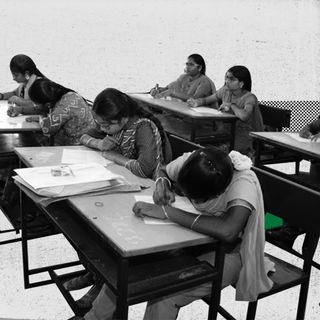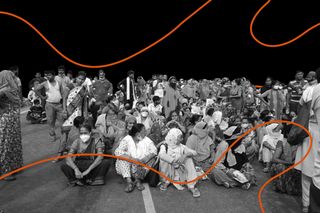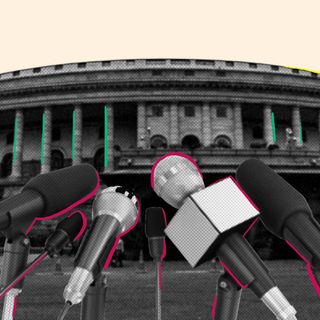
Khori Gaon Residents Left Homeless as Govt Rehabilitation Plan Excludes Most People
The demolition drive began in Faridabad this week — rendering more than one lakh people homeless without government rehabilitation.

The Faridabad civic body razed down 10,000 houses in the Khori colony this week, as part of the Supreme Court order to clear the forest land where more than one lakh people live. While the Haryana government announced a rehabilitation scheme on Tuesday, many experts and residents have expressed concern that the bulk of residents will be ineligible for these policies due to mandatory ID proof requirements.
The Khori Gaon basti, part of the protected Aravali forest land, is situated on the border between Delhi and Haryana. Residents have lived there since the 1980s. Recently, a Supreme Court order noted their village is an “encroachment” on the forest land and ordered the demolition of their dwellings — a move that was criticized by several activists and experts, in addition to the residents.
The Faridabad civic body’s rehabilitation scheme (called Policy for Rehabilitation of Khori Jhuggi Dwellers) for locals displaced was announced on Tuesday, but it may be insufficient to offer relief. Activists say the loophole lies in the fine print: only people with ID proofs issued by the Haryana government will be able to avail the benefits. However, most residents in the village carry documentation issued by the Delhi government.
“First the authorities were reluctant to provide any rehabilitation and now that they have announced a scheme, most people will automatically be excluded from it as we have ID proofs of Delhi… Also, even before giving us a place to stay, the authorities have demolished our houses,” Rekha, 35, a resident of Khori, told Hindustan Times.
The resettlement plan excludes 95% of those who are being displaced, The Quint noted.
The Khori village razing is jarring for two reasons. Not only were the locals evicted from the land that has been their home for decades, but the demolition was carried without prior rehabilitation arrangements. Even the petition in the SC that challenged the demolition noted it constituted a violation of the families’ right to housing.
On Thursday, reports and videos of residents being lathi-charged surfaced on the internet. Other testimonies of residents undergird the gravity. Most people have been impacted economically due to the pandemic. “The basti residents have suffered Covid deaths, starvation, and loss of jobs,” Manju Menon from the Centre for Policy Research and Choudhary Ali Zia Kabir, a housing rights advocate noted in The Wire.
The idea of home and identity is critical to any individual. Menon and Zia Kabir note how these “manipulations” by the governments and the very rule of law have cornered residents, who built these dwellings. Now, the tussle between land rights, documentation as proof of belonging, and human dignity all skew against Khori village residents.
Related on The Swaddle:
SC Orders Removal of Over 10,000 Slum Dwellings From Haryana’s Aravali Forest Land
The policy proposed to resettle the Khori gaon residents was put forth to quell protests. The requirements within the policy are such: the applicant’s annual family income does not exceed ₹3 lakh and they must fulfill one of three conditions — their name is registered in the Haryana’s Badkhal assembly constituency voter list as of January 1, 2021; they have an electricity bill from Dakshin Haryana Bijli Vitran Nigam in their name; or an adult earning member or head of the family has a Parivar Pehchan Patra issued by the state of Haryana as on January 1, 2021. If a family fulfills one of the above conditions, they will be allotted a flat with an area of 30 square meters in Dabua Colony and Bapu Nagar. The residents have been promised ₹2,000 per month till then.
“The current clauses make most of the residents ineligible for rehabilitation,” Ishita Chatterjee, a Ph.D. scholar with the Faculty of Architecture, Building, and Planning at the University of Melbourne, told Hindustan Times.
The confusion is over the Haryana-Delhi jurisdiction, and where the Khori gaon residents fall. Most Khori gaon residents possess identity cards issued by the Delhi government. “A majority of Khori residents hold Delhi ID cards, voter IDs, ration cards. They have been provided basic facilities like electricity, gas connection, paved roads, and anganwadis by the Delhi government, and all their children go to schools in Delhi” Nilesh Kumar, a social worker associated with the Basti Suraksha Manch, noted.
In 2016, a high court asked the Haryana government to look after the rehabilitation plan as the land belonged to the Haryana government. But, another legal policy by the Delhi Urban Shelter Improvement Board in 2015 noted if people have been living in any settlement before 2015 and possess identity cards from Delhi, then they must also be rehabilitated under this policy. A group of social activists and scholars noted in a letter that Khori villagers are entitled to relief and rehabilitation under the DUSUB Act, 2015.
Moreover, many people do not have identity proofs verified by either government. “While government officials charged huge sums of money when we were building our houses, they created hurdles when we wanted residential and ID proofs. So, many people here do not have documents to prove that they are residents of either Delhi or Haryana,” Rekha Chaurasia, a resident, told The Quint.
Moreover, those who are eligible to avail the benefits and the new flats also note the poor condition of the houses and the hefty cost.
The intent, action, and timing of the incident all weigh heavily on residents. For Dharmendra, a resident, one question lingers. “Why did the government,” he says to The Quint, “raze our homes when the alternate facility wasn’t even ready?”
Saumya Kalia is an Associate Editor at The Swaddle. Her journalism and writing explore issues of social justice, digital sub-cultures, media ecosystem, literature, and memory as they cut across socio-cultural periods. You can reach her at @Saumya_Kalia.
Related


Women in Healthcare Are Paid Far Less Than Men, Study Shows
